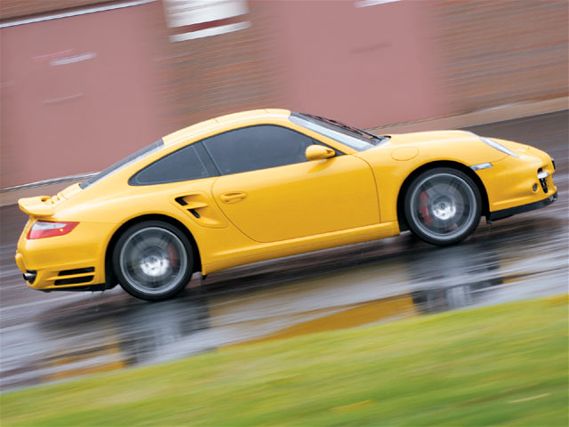 | Porsche 997 TT - Project 997>TT
| Porsche 997 TT - Project 997>TT
In the project introduction, we witnessed an easy 20 wheel-hp gain from a simple Fabspeed turbo-back exhaust, taking us from a 429 all-wheel horsepower (AWHP) baseline to 449 (ec, May '07). The exhaust features free-flowing chambers and high-flow cats, and all testing was done on Imagine Auto's all-wheel dynamometer using 91-octane pump gas and stock software.
For this installment, we're tackling stage one, two and three upgrades as offered by both Imagine Auto and Evolution Motorsports. Keep in mind our intake system remains stock.
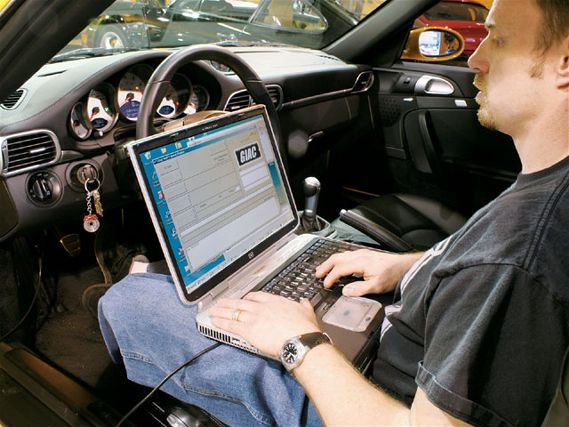 | Porsche 997 TT - Project 997>TT
| Porsche 997 TT - Project 997>TT
The IA stage one upgrade for the 997 TT is an ECU upgrade, tuned by GIAC. The software gets the most out of the turbos boost-wise, while keeping levels at a safe 18 psi in Sport mode. Overboost mode is still from 2000 to 5000 rpm, after which the boost starts tapering off a bit, to keep exhaust gas temps down and let the expensive variable geometry turbos (VGT) live a long life. In non-Sport mode, the drive-by-wire set-up is retained, but you can really feel the difference when the Sport button is hit. For this mode, GIAC has calibrated the throttle mapping to respond like a true cable throttle body.
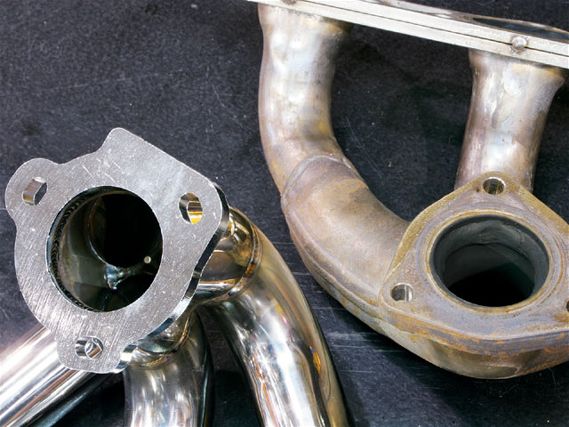 | Porsche 997 TT - Project 997>TT
| Porsche 997 TT - Project 997>TT
On the dyno, we tested the new software with the factory exhaust back in place, to see the actual gain from software alone. As with almost any factory turbocharged car, the biggest gains for the money are here. We saw 473 AWHP and 475 lb-ft of torque, with a peak gain of 64 hp and 62 lb-ft of torque at 5350 rpm. Even better, after IA and Evolution found that the exhaust gas temperature with the factory software was a little high, they found their stage one software took it more than 100 degrees C (212 degrees F) lower.
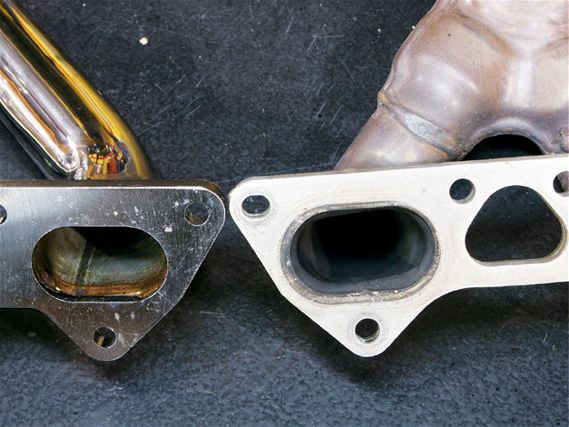 | Porsche 997 TT - Project 997>TT
| Porsche 997 TT - Project 997>TT
Stage two comprises the software upgrade and the cat-back exhaust. It's the same Fabspeed exhaust we tested last time, but different things happen when a turbo-back exhaust is coupled with higher boost and more aggressive fuel and ignition maps. If you can afford stage one, you'd be crazy not to want stage two.
Power shot up to 514 AWHP and 523 lb-ft of torque. It spools so quickly that it's already making 300 lb-ft by 2500 rpm. Peak gains over baseline are 100 hp and 100 lb-ft of torque at 5250 rpm. At this level, the Turbo should be good for mid-11-second passes with 120-mph traps on street tires in the quarter-mile, yet it can also rip out of any turn on the road course in practically any gear. Doesn't seem fair.
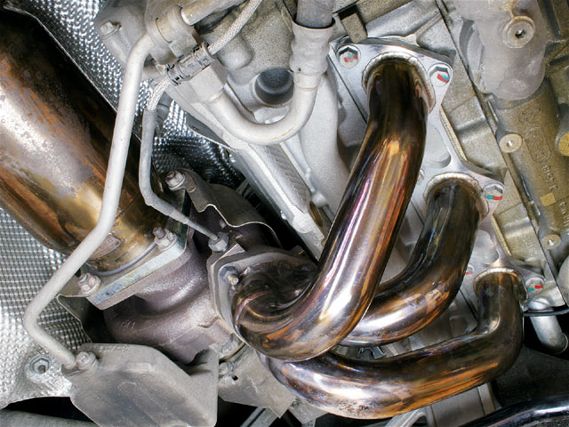 | Porsche 997 TT - Project 997>TT
| Porsche 997 TT - Project 997>TT
Stage three uses the IA header system. The TIG-welded pipes are made from 321 stainless steel to handle the heat, using a wide-mouth, triangular collector as opposed to the semi-flat merge on the factory manifold. The piping is about eight percent larger, the primary entries about five percent larger, and the collector opening is a considerable 30 percent larger than stock. The factory welds, which could be cleaner on the inside, are mainly to blame for the smaller primary and collector openings. But it would only be a problem if the stock headers were a bottleneck. The only way to find out was to strap it back on the dyno. We found that the factory headers flow well at this power level, but the new ones still improve the bottom line. The car ripped off 522 AWHP with a slight drop in mid-range torque to 520 lb-ft. By themselves, the headers don't give huge gains, but they'll come in handy when this car is equipped with larger turbos that will need the extra flow.
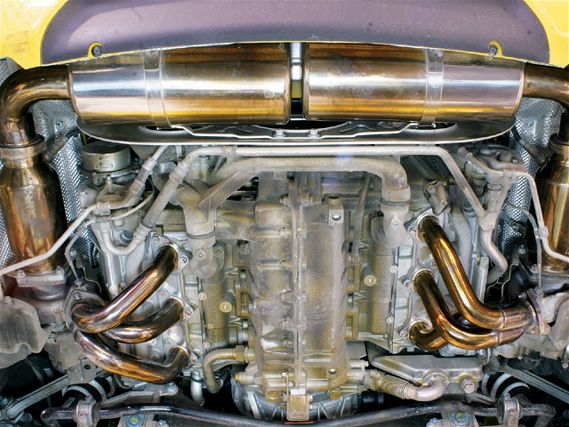 | Porsche 997 TT - Project 997>TT
| Porsche 997 TT - Project 997>TT
On the road, the new power really puts the all-wheel-drive system to the test. Even with the mechanical grip and the big tires (245s front, 305s rear), it tears through first gear with tire-spinning fury, then the car catapults forward. In second gear, it still feels on the brink of breaking loose-520 lb-ft makes for quite the violent animal. At highway speeds, all that torque translates into a stomach-dropping, warped experience. Thanks to the VGT's instant spool, cruising in fifth at 3000 rpm still provides an astonishing 400 lb-ft of torque; it'll make you lazy when it comes to downshifting. In stock trim, Project 997 TT was fast. But now we know what it's like with an extra 109 hp at 5350 rpm and 100 lb-ft from 4600 to 5500 rpm. And we're not done yet.
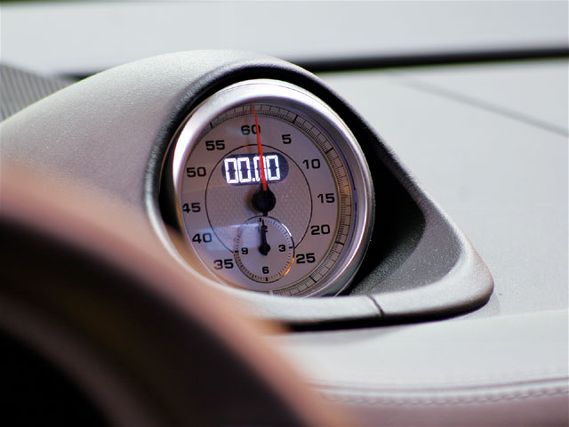 | Porsche 997 TT - Project 997>TT
| Porsche 997 TT - Project 997>TT
